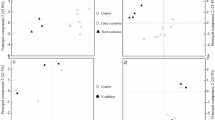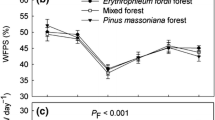Abstract
Deciduous forests may respond differently from coniferous forests to the anthropogenic deposition of nitrogen (N). Since fungi, especially ectomycorrhizal (EM) fungi, are known to be negatively affected by N deposition, the effects of N deposition on the soil microbial community, total fungal biomass and mycelial growth of EM fungi were studied in oak-dominated deciduous forests along a nitrogen deposition gradient in southern Sweden. In-growth mesh bags were used to estimate the production of mycelia by EM fungi in 19 oak stands in the N deposition gradient, and the results were compared with nitrate leaching data obtained previously. Soil samples from 154 oak forest sites were analysed regarding the content of phospholipid fatty acids (PLFAs). Thirty PLFAs associated with microbes were analysed and the PLFA 18:2ω6,9 was used as an indicator to estimate the total fungal biomass. Higher N deposition (20 kg N ha−1 y−1 compared with 10 kg N ha−1 y−1) tended to reduce EM mycelial growth. The total soil fungal biomass was not affected by N deposition or soil pH, while the PLFA 16:1ω5, a biomarker for arbuscular mycorrhizal (AM) fungi, was negatively affected by N deposition, but also positively correlated to soil pH. Other PLFAs positively affected by soil pH were, e.g., i14:0, a15:0, 16:1ω9, a17:0 and 18:1ω7, while some were negatively affected by pH, such as i15:0, 16:1ω7t, 10Me17:0 and cy19:0. In addition, N deposition had an effect on the PLFAs 16:1ω7c and 16:1ω9 (negatively) and cy19:0 (positively). The production of EM mycelia is probably more sensitive to N deposition than total fungal biomass according to the fungal biomarker PLFA 18:2ω6,9. Low amounts of EM mycelia covaried with increased nitrate leaching, suggesting that EM mycelia possibly play an important role in forest soil N retention at increased N input.








Similar content being viewed by others
References
Aber JD, Mc.Dowell W, Nadelhoffer K, Magill A, Berntson G, Kamakea M, McNulty S, Currie Rustad L, Fernandez I (1998) Nitrogen saturation in temperate forest ecosystems. Hypothesis revisited. BioScience 48:921–934
Arnebrant K (1994) Nitrogen amendments reduce the growth of extramatrical mycelium. Mycorrhiza 5:7–15
Bååth E, Anderson TH (2003) Comparison of soil fungal/bacterial ratios in a pH gradient using physiological and PLFA-based techniques. Soil Biol Biochem 35:955–963
Bååth E, Spokes J (1989) The effect of added nitrogen and phosphorous on mycorrhizal growth-response and infection in Allium Schoenoprasum. Can J Bot 67:3227–3232
Bååth E, Frostegård Å, Pennanen T, Fritze H (1992) Soil bacterial biomass, activity phospholipid fatty-acid pattern, and pH tolerance in an area polluted with alkaline dust deposition. Appl Environ Microbiol 58:4026–4031
Bååth E, Frostegård Å, Pennanen T, Fritze H (1995) Microbial community structure and pH response in relation to soil organic matter quality in wood-ash fertilized clear-cut or burned coniferous forest soils. Soil Biol Biochem 27:229–240
Bååth E, Nilsson LO, Göransson H, Wallander H (2004) Can the extent of degradation of soil fungal mycelium during soil incubation be used to estimate ectomycorrhizal biomass in soil? Soil Biol Biochem 36:2105–2109
Bossio DA, Scow KM, Gunapala N, Graham KJ (1998) Determinants of soil microbial communities: Effects of agricultural management, season, and soil type on phospholipid fatty acid profiles. Micr Ecol 36:1–12
Brunet J, Diekmann M, Falkengren-Grerup U (1998) Effects of nitrogen deposition on field layer vegetation in south Swedish oak forests. Environ Pollut 102:35–40
Büttner V, Leuschner C (1994) Spatial and temporal patterns of fine root abundance in a mixed oak-beech forest. For Ecol Manage 70:11–21
Coutts MP, Nicoll BC (1991) Growth and survival of shoots, roots, and mycorrhizal mycelium in clonal Sitka spruce during the 1st growing-season after planting. Can J For Res 20:861–868
de Vries W, Reinds GJ, Vel E (2003) Intensive monitoring of forest ecosystems in Europe 2: 430 atmospheric deposition and its impacts on soil solution chemistry. For Ecol Manage 174:97–115
Emmett BA, Kjonaas OJ, Gundersen P, Koopmans C, Tietema A, Sleep D (1998) Natural abundance of 15N in forests across a nitrogen deposition gradient. For Ecol Manage 101:9–18
Falkengren-Grerup U, Diekmann M (2003) Use of a gradient of N-deposition to calculate effect-related soil and vegetation measures in deciduous forests. For Ecol Manage 180:113–124
Frostegård Å, Bååth E (1996) The use of phospholipid fatty acid analysis to estimate bacterial and fungal biomass in soil. Biol Fertil Soils 22:59–65
Frostegård Å, Tunlid A, Bååth E (1991) Microbial biomass measured as total lipid phosphate in soils of different organic content. J Microbiol Methods 14:151–163
Frostegård Å, Tunlid A, Bååth E (1993a) Phospholipid fatty acid composition, biomass and activity of microbial communities from two soil types experimentally exposed to different heavy metals. Appl Environ Microbiol 59:3605–3617
Frostegård Å, Bååth E, Tunlid A (1993b) Shifts in the structure of soil microbial communities in limed forests as revealed by phspholipid fatty-acid analysis. Soil Biol Biochem 25:723–730
Galloway JN, Aber JD, Erisman JW, Seitzinger SP, Howarth RW, Cowling EB, Cosby BJ (2003) The nitrogen cascade. BioScience 53:341–356
Göransson H, Wallander H, Ingerslev M, Rosengren U (2006) Estimating the relative nutrient uptake from different soil depths of Quercus robur, Fagus sylvatica, and Picea abies. Plant Soil 286:87–97
Griffiths BS, Ritz K, Ebblewhite N, Dobson G (1999) Soil microbial community structure: effects of substrate loading rates. Soil Biol Biochem 31:145–153
Gundersen P, Callesen I, de Vries W (1998) Nitrate leaching in forest ecosystems is related to forest floor C/N ratios. Environ Pollut 102:403–407
Hendricks JJ, Mitchell RJ, Kuehn KA, Pecot SD, Sims SE (2006) Measuring external mycelia production of ectomycorrhizal fungi in the field: the soil matrix matters. New Phytol 171:179–186
Högberg MN, Bååth E, Nordgren A, Arnebrant K, Högberg P (2003) Contrasting effects of nitrogen availability on plant carbon supply to mycorrhizal fungi and saprotrophs—a hypothesis based on field observations in boreal forest. New Phytol 160:225–238
Holmqvist J, Thelin G, Rosengren U, Stjernquist I, Wallman P, Sverdrup H (2002) Assesment of sustainability in the Asa Forest Park. In: Sverdrup H, Stjernquist I (eds) Developing principles and models for sustainable forestry in Sweden. Kluwer, Dordrecht, pp 355–380
Johnson NC, Rowland DL, Corkidi L, Egerton-Warburton LM, Allen EB (2003) Nitrogen enrichment alters mycorrhizal allocation at five mesic to semiarid grasslands. Ecology 84:1895–1908
Kristensen HL, Gundersen P, Callesen I, Reinds GJ (2004) Throughfall nitrogen deposition has different impacts on soil solution nitrate concentration in European coniferous and deciduous forests. Ecosystems 7:180–192
Larsen J, Olsson PA, Jakobsen I (1998) The use of fatty acid signatures to study mycelial interactions between the arbuscular mycorrhizal fungus Glomus intraradices and the saprotrophic fungus Fusarium culmorum in root-free soil. Mycol Res 102:1491–1496
Leckie SE, Prescott CE, Grayston SJ, Neufeld JD, Mohn WW (2004) Characterization of humus microbial communities in adjacent forest types that differ in nitrogen availability. Microb Ecol 48:29–40
Lovett G, Weathers KC, Arthur MA (2002) Control of nitrogen loss from forested watersheds by soil carbon:nitrogen ratio and tree species composition. Ecosystems 5:712–718
Myers RT, Zak DR, White DC, Peacock A (2001) Landscape-level patterns of microbial community composition and substrate use in upland forest ecosystems. Soil Sci Soc Am J 65:359–367
Nilsson LO, Wallander H (2003) Production of external mycelium by ectomycorrhizal fungi in a Norway spruce forest was reduced in response to nitrogen fertilization. New Phytol 158:409–416
Nilsson LO, Giesler R, Bååth E, Wallander H (2005) Growth and biomass of mycorrhizal mycelia in coniferous forests along short natural nutrient gradients. New Phytol 165:613–622
Nilsson LO, Wallander H, Bååth E, Falkengren-Grerup U (2006) Soil N chemistry in oak forests along a nitrogen deposition gradient. Biogeochemistry 80:43–55
Olsson PA (1999) Signature fatty acids provide tools for determination of the distribution and interactions of mycorrhizal fungi in soil. FEMS Microbiol Ecol 29:303–310
Olsson PA, Johansen A (2000) Lipid and fatty acid composition of hyphae and spores of arbuscular mycorrhizal fungi at different growth stages. Mycol Res 104:429–434
Olsson PA, Tyler G (2004) Occurrence of non-mycorrhizal plant species in south Swedish rocky habitats is related to exchangeable soil phosphate. J Ecol 92:808–815
Olsson M, Rosén K, Melkerud PA (1993) Regional modelling of base cation losses from Swedish forest soils due to whole-tree harvesting. Appl Geochem (Suppl) 2:189–194
Pennanen T, Liski J, Bååth E, Kitunen V, Uotila J, Westman CJ, Fritze H (1999) Structure of the microbial communities in coniferous forest soils in relation to site fertility and stand development stage. Microb Ecol 38:168–179
Stober C, George E, Persson H (2000) Root growth and response to nitrogen. In: Schulze ED (ed) Carbon and nitrogen cycling in European forest ecosystems. Springer, Berlin, pp 99–121
Tamm CO (1991) Nitrogen in terrestrial ecosystems. Questions of productivity, vegetational changes, and ecosystem stability. Springer, Berlin
Tietema A (1998) Microbial carbon and nitrogen dynamics in coniferous forest floor material collected along a European nitrogen deposition gradient. For Ecol Manage 101:29–36
van Aarle IM, Olsson PA, Söderström B (2002) Arbuscular mycorrhizal fungi respond to the substrate pH of their extraradical mycelium by altered growth and root colonization. New Phytol 155:173–182
Waldrop MP, Zak DR, Sinsabaugh RL (2004) Microbial community response to nitrogen deposition in northern forest ecosystems. Soil Biol Biochem 36:1443–1451
Wallander H, Nilsson LO, Hagerberg D, Bååth E (2001) Estimation of the biomass and seasonal growth of external mycelium of ectomycorrhizal fungi in the field. New Phytol 151:753–760
Wallander H, Nylund JE (1992) Effects of excess nitrogen and phosphorus starvation on the extramatrical mycelium of ectomycorrhizas of Pinus sylvestris L. New Phytol 120:495–503
Wallenda T, Kottke I (1998) N deposition and ectomycorrhizas. New Phytol 139:169–187
Westling O (2001) Kväveupplagringen ökar i skogsmark (in Swedish). In: MISTRA (ed) Effekter av gränsöverskridande luftföroreningar i Sverige. Annual ASTA Report (International and national abatement strategies for transboundary air pollution). MISTRA, Solna, Sweden, pp 14–15
Acknowledgments
We would like to thank Martin Diekmann for allowing us to use his data from sites on Öland and in Småland, and Anita Balogh for the preparation of the ion-exchange resins and laboratory analysis. Financial support was provided by the Swedish Research Council for Environment, Agricultural Sciences and Spatial Planning (Formas). We confirm that the experiments performed in this study comply with current Swedish legislation.
Author information
Authors and Affiliations
Corresponding author
Additional information
Communicated by Christian Körner.
Rights and permissions
About this article
Cite this article
Nilsson, L.O., Bååth, E., Falkengren-Grerup, U. et al. Growth of ectomycorrhizal mycelia and composition of soil microbial communities in oak forest soils along a nitrogen deposition gradient. Oecologia 153, 375–384 (2007). https://doi.org/10.1007/s00442-007-0735-x
Received:
Accepted:
Published:
Issue Date:
DOI: https://doi.org/10.1007/s00442-007-0735-x




